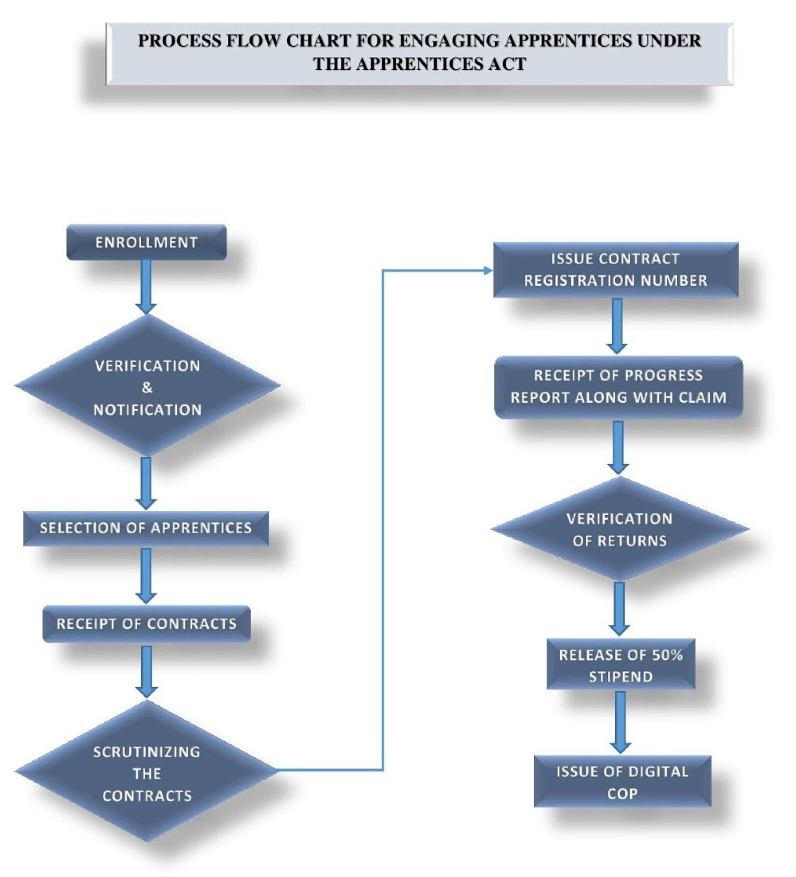Before we dive into the scope of how apprenticeships can benefit organizations, let us understand the correct meaning of the term. Vocabulary.com defines “Apprenticeship as a kind of job training that involves following and studying a master of the trade on the job instead of in school. Carpenters, masons, doctors, and many other professionals often learn their trade through apprenticeship.
This is the universal definition to apprentice, and it is no different from the original and founding definition of Apprenticeship in India from The Apprentice Act, 1961. “Apprenticeship Training” means a course of training in any industry or establishment undergone in pursuance of a contract of apprenticeship and under prescribed terms and conditions which may be different for different categories of apprentices.”
It is to be noted that the Apprenticeship Act solely governs all apprentice laws, regulations, policies, and schemes.
Apprenticeship training is one of the most efficient ways to develop a skilled workforce for any industry by using training facilities available in the establishments without the need to set up an independent training infrastructure. In line with the benefits that were identified for promoting apprenticeship in the country, comprehensive amendments to Apprentices Act 1961 are made periodically. The Act has been made more responsive to industry and youth. Employers can now engage up to 10% of its total workforce as apprentices. As a result, the number of apprentices in the country has increased from 2.70 lakh to 3.10 lakh in the past one year.
While not even 30% of Indian companies hire apprentices, world nations operate on the apprentice-to-employee approach to employment. In a survey commissioned by the UK government in 2017, 86% of employers reported benefiting from ‘the development of skills relevant to the organization’ by hiring apprentices.
Only 10% of the total workforce in the country receives skill training. 80% of the entrants into the workforce do not have the opportunity for skill training.


What does The Apprenticeship Programme encompass?
The Apprenticeship Programme in India is governed under the Apprentices Act 1961 and is implemented by the Ministry of Skill Development and Entrepreneurship (MSDE) at the national level.
- The apprenticeships curriculum have been designed in partnership with industry in order to plug existing skills gaps, meaning your employee will be learning what they need for success in their chosen field.
- It is obligatory on the part of employers having human resources strength 40 or more and having requisite training infrastructure as laid down in the Act, to engage apprentices. The employer shall hire of apprentices in a band of 2.5% to 10% of total workforce strength of the establishments, including contractual staff.
Also Read: Why the New Apprenticeship Outlook and Index is a Must Read
The common types of apprentices and their position in the job market:
- Trade apprentices
- Graduate apprentices
- Technician apprentices
- Technician (Vocational) apprentices
- Optional trade apprentices
The employers can decide the categories of apprentices and trade(s) in which the apprentices are to be engaged depending upon the facility available with them for imparting on-the-job training/ practical training at their workplace. Apprenticeship Training can be provided to apprentices both in designated and optional trade (Designated trade means any trade or occupation as notified by the Government and optional trade means any trade or occupation decided by an employer). The scope of operation for an apprentice is extended to organizations of all sizes, especially the corporate sector and particularly for the management and service sector.
The National Apprenticeship Promotion Scheme (NAPS) has also recently received a cabinet approval of 10,000 crores, in which it is proposed to provide 25% of stipend payable to apprentices as a subsidy to employers as it will motivate employers to engage more apprentices.
- Reimbursement of 25% of prescribed stipend subject to a maximum of Rs. 1500/-per month per apprentice by the Government of India to all employers who engage apprentices.
- Reimbursement of expenditure on basic training limited to Rs. 7500/- for a maximum of 500 hours/3 months @ Rs. 15/hour, by the Government of India to Basic Training Providers (BTPs) in respect of fresher apprentices who come directly for apprenticeship training without any formal training.
NAPS has the following two components:
You may also be interested in: 2019 Changes to the Apprenticeship Rules
The Government has notified changes in Apprenticeship Rules (1992) that envisages increasing the skilled workforce in the country and raise monetary compensation of apprentices. The Apprenticeship (Amendment) Rules, 2019, seeks to raise the hiring limit of apprentices to 15 percent of the total strength of an establishment/organization, and their stipend to up to Rs. 9,000 per month.
As per the new rules, notified with effect from September 25, the minimum amount of stipend prescribed ranges from Rs 5,000 per month – for school pass outs between Class 5th and 9th – to Rs 9,000 per month to graduate or degree apprentices in any stream.
Apprenticeship Portal
To make things easier for the youth as well as the industry, an apprenticeship portal has also been recently launched by the Prime Minister, where all companies would be required to publish their trade-wise requirement of apprentices. This would serve as a convenient platform to match the demand and supply of apprentices across industries and geographies. Apprentices are now encouraged to apply online, and apprenticeship contract approval would also be online. This would make way for online interaction among apprenticeship applicants, Government, and the corporates. The Corporates would publish apprenticeship details on this portal instead of submitting tedious returns, and the Government would get data directly from the portal.
It is therefore clear that the government regulations and schemes deployed are working toward bridging the gap between the need for skilled manpower in the market while simultaneously producing skilled labor through extensive apprenticeship programs. It is now the responsibility of the public and private sector organizations, by way of policy reformations that will enable the speedy employment of these apprentices. Corporates can avail of the benefits offered by the Government and be profited while enabling the growth of the country by engaging apprentices in their organization.












